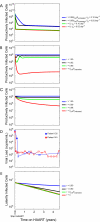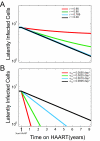Low-level HIV-1 replication and the dynamics of the resting CD4+ T cell reservoir for HIV-1 in the setting of HAART
- PMID: 18171475
- PMCID: PMC2254415
- DOI: 10.1186/1471-2334-8-2
Low-level HIV-1 replication and the dynamics of the resting CD4+ T cell reservoir for HIV-1 in the setting of HAART
Abstract
Background: In the setting of highly active antiretroviral therapy (HAART), plasma levels of human immunodeficiency type-1 (HIV-1) rapidly decay to below the limit of detection of standard clinical assays. However, reactivation of remaining latently infected memory CD4+ T cells is a source of continued virus production, forcing patients to remain on HAART despite clinically undetectable viral loads. Unfortunately, the latent reservoir decays slowly, with a half-life of up to 44 months, making it the major known obstacle to the eradication of HIV-1 infection. However, the mechanism underlying the long half-life of the latent reservoir is unknown. The most likely potential mechanisms are low-level viral replication and the intrinsic stability of latently infected cells.
Methods: Here we use a mathematical model of T cell dynamics in the setting of HIV-1 infection to probe the decay characteristics of the latent reservoir upon initiation of HAART. We compare the behavior of this model to patient derived data in order to gain insight into the role of low-level viral replication in the setting of HAART.
Results: By comparing the behavior of our model to patient derived data, we find that the viral dynamics observed in patients on HAART could be consistent with low-level viral replication but that this replication would not significantly affect the decay rate of the latent reservoir. Rather than low-level replication, the intrinsic stability of latently infected cells and the rate at which they are reactivated primarily determine the observed reservoir decay rate according to the predictions of our model.
Conclusion: The intrinsic stability of the latent reservoir has important implications for efforts to eradicate HIV-1 infection and suggests that intensified HAART would not accelerate the decay of the latent reservoir.
Figures




Similar articles
-
Limits on replenishment of the resting CD4+ T cell reservoir for HIV in patients on HAART.PLoS Pathog. 2007 Aug 31;3(8):e122. doi: 10.1371/journal.ppat.0030122. PLoS Pathog. 2007. PMID: 17784786 Free PMC article.
-
Reservoirs for HIV-1: mechanisms for viral persistence in the presence of antiviral immune responses and antiretroviral therapy.Annu Rev Immunol. 2000;18:665-708. doi: 10.1146/annurev.immunol.18.1.665. Annu Rev Immunol. 2000. PMID: 10837072 Review.
-
Suppression of HIV replication in the resting CD4+ T cell reservoir by autologous CD8+ T cells: implications for the development of therapeutic strategies.Proc Natl Acad Sci U S A. 2001 Jan 2;98(1):253-8. doi: 10.1073/pnas.98.1.253. Proc Natl Acad Sci U S A. 2001. PMID: 11136258 Free PMC article.
-
A stable latent reservoir for HIV-1 in resting CD4(+) T lymphocytes in infected children.J Clin Invest. 2000 Apr;105(7):995-1003. doi: 10.1172/JCI9006. J Clin Invest. 2000. PMID: 10749578 Free PMC article.
-
The challenge of viral reservoirs in HIV-1 infection.Annu Rev Med. 2002;53:557-93. doi: 10.1146/annurev.med.53.082901.104024. Annu Rev Med. 2002. PMID: 11818490 Review.
Cited by
-
Cellular HIV-1 DNA levels in drug sensitive strains are equivalent to those in drug resistant strains in newly-diagnosed patients in Europe.PLoS One. 2010 Jun 8;5(6):e10976. doi: 10.1371/journal.pone.0010976. PLoS One. 2010. PMID: 20544014 Free PMC article.
-
HIV-1 latency in actively dividing human T cell lines.Retrovirology. 2008 Apr 25;5:37. doi: 10.1186/1742-4690-5-37. Retrovirology. 2008. PMID: 18439275 Free PMC article.
-
Antibody response to Achromobacter xylosoxidans during HIV infection is associated with lower CD4 levels and increased lymphocyte activation.Clin Vaccine Immunol. 2014 Jan;21(1):46-50. doi: 10.1128/CVI.00553-13. Epub 2013 Oct 30. Clin Vaccine Immunol. 2014. PMID: 24173027 Free PMC article.
-
Mathematical Models of HIV-1 Dynamics, Transcription, and Latency.Viruses. 2023 Oct 19;15(10):2119. doi: 10.3390/v15102119. Viruses. 2023. PMID: 37896896 Free PMC article. Review.
-
Analysis of human immunodeficiency virus type 1 viremia and provirus in resting CD4+ T cells reveals a novel source of residual viremia in patients on antiretroviral therapy.J Virol. 2009 Sep;83(17):8470-81. doi: 10.1128/JVI.02568-08. Epub 2009 Jun 17. J Virol. 2009. PMID: 19535437 Free PMC article.
References
-
- Chun TW, Carruth L, Finzi D, Shen X, DiGiuseppe JA, Taylor H, Hermankova M, Chadwick K, Margolick J, Quinn TC, Kuo YH, Brookmeyer R, Zeiger MA, Barditch-Crovo P, Siliciano RF. Quantification of latent tissue reservoirs and total body viral load in HIV-1 infection. Nature. 1997;387:183–188. doi: 10.1038/387183a0. - DOI - PubMed
-
- Finzi D, Hermankova M, Pierson T, Carruth LM, Buck C, Chaisson RE, Quinn TC, Chadwick K, Margolick J, Brookmeyer R, Gallant J, Markowitz M, Ho DD, Richman DD, Siliciano RF. Identification of a reservoir for HIV-1 in patients on highly active antiretroviral therapy. Science. 1997;278:1295–1300. doi: 10.1126/science.278.5341.1295. - DOI - PubMed
-
- Hermankova M, Siliciano JD, Zhou Y, Monie D, Chadwick K, Margolick JB, Quinn TC, Siliciano RF. Analysis of human immunodeficiency virus type 1 gene expression in latently infected resting CD4+ T lymphocytes in vivo. J Virol. 2003;77:7383–7392. doi: 10.1128/JVI.77.13.7383-7392.2003. - DOI - PMC - PubMed
Publication types
MeSH terms
Grants and funding
LinkOut - more resources
Full Text Sources
Other Literature Sources
Medical
Research Materials

